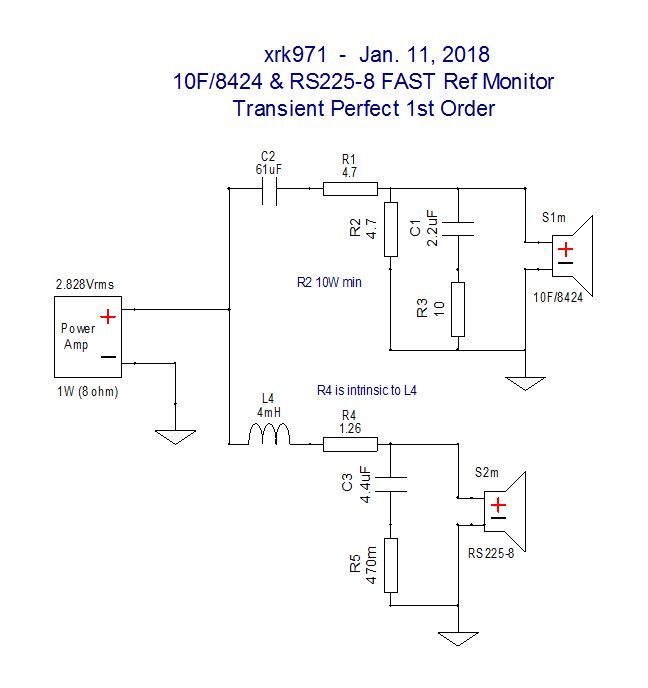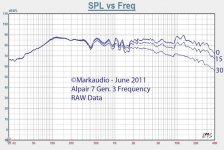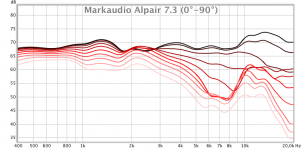You can probably start with the passive crossover from the 10F/RS225 WAW / FAST speaker which was designed for a 3.5in class full range at 7in CTC spacing with the woofer. It must have a 10in wide baffle and the Dayton RS225 8ohm aluminum cone woofer. The crossover is about 900Hz and assumes an 87dB sensitivity full range that is nominally 8ohms. Adjust the R1/R2 padding resistors to suit taste for blending the two.
https://www.diyaudio.com/community/threads/10f-8424-rs225-8-fast-waw-ref-monitor.273524/

MAO7P is about a 4in class driver I think and 86dB. So maybe change R1 to 3.3ohm and R2 to 7ohm.
If you want to cross lower, it will then have to be done from scratch.
https://www.diyaudio.com/community/threads/10f-8424-rs225-8-fast-waw-ref-monitor.273524/
MAO7P is about a 4in class driver I think and 86dB. So maybe change R1 to 3.3ohm and R2 to 7ohm.
If you want to cross lower, it will then have to be done from scratch.
The XO for the A7 MAOP will be the same as one for the A7.3.
We happily used M7 with a pair of A12pw in our big MTM with the passive XO.
I am biamping my other big WAW which will have M7 in it when i get round to it.
I would pay little attention to X;s xo which is for a completely different driver.
Scott has also done first pass XO for A7.3 in Nanosaurus crossed to a single A12pw.
dave
We happily used M7 with a pair of A12pw in our big MTM with the passive XO.
I am biamping my other big WAW which will have M7 in it when i get round to it.
I would pay little attention to X;s xo which is for a completely different driver.
Scott has also done first pass XO for A7.3 in Nanosaurus crossed to a single A12pw.
dave
The MTM is t 250 Hz. The first order passive did not work near s well as 1st order active, the passive ended up 4th order acoustic.
Scott’s are simpler, not sure exactly where it is, but similar.
dave
Scott’s are simpler, not sure exactly where it is, but similar.
dave
Since you already invested in MAOPs over less expensive options you should try to go with go a 1st order passive line level XO unless there is very good reason you can't.
They will give you vastly superior sound to passive, with a WAW it is the absolute worst case scenario for passive in sound, size and cost.
1st order always sounds best to me if the driver can handle it, fullrange drivers will handle it but it is more a question of how well.
1st order at 250Hz the MAOP 7 will still have a lot work to do, although that has its own advantages
'Ideal' XO is very subjective and very situational, whatever XO recommended here, even for your exact drivers, will not very likely not sound as a good as the one you tuned to your own tastes IME.
Easy enough to fine tune an XO with PLL, even easier to use this technique to figure out the perfect XO and then convert it to PLL.
You will probably find multiple narrow sweet spots.
Another con of passive XO - lack of cheaper fine value and low tolerance parts, and variable driver impedance, you may not hit the sweet spot even if you know where it is.
If you need help with XO circuits this tool will help you with that too.
Remember to factor in source output impedance and amp input impedance.
Sorry, this isn't really what you asked but passive makes little sense outside of commercial speakers where most people want or expect 'plug and play' speakers.
They will give you vastly superior sound to passive, with a WAW it is the absolute worst case scenario for passive in sound, size and cost.
1st order always sounds best to me if the driver can handle it, fullrange drivers will handle it but it is more a question of how well.
1st order at 250Hz the MAOP 7 will still have a lot work to do, although that has its own advantages
'Ideal' XO is very subjective and very situational, whatever XO recommended here, even for your exact drivers, will not very likely not sound as a good as the one you tuned to your own tastes IME.
Easy enough to fine tune an XO with PLL, even easier to use this technique to figure out the perfect XO and then convert it to PLL.
You will probably find multiple narrow sweet spots.
Another con of passive XO - lack of cheaper fine value and low tolerance parts, and variable driver impedance, you may not hit the sweet spot even if you know where it is.
If you need help with XO circuits this tool will help you with that too.
Remember to factor in source output impedance and amp input impedance.
Sorry, this isn't really what you asked but passive makes little sense outside of commercial speakers where most people want or expect 'plug and play' speakers.
Last edited:
even easier to use this technique to figure out the perfect XO and then convert it to PLL.
This technique need two amplifier? I use camilla dsp. My source is RPI4 with SPDIF card and Moode audio software on RPI4
This technique need two amplifier? I use camilla dsp. My source is RPI4 with SPDIF card and Moode audio software on RPI4
no, you use the right and left channel of any stereo amp
you are only doing for design stage with one speaker , woofer on one channel, MOAP on other.
you will need two amps for completed stereo pair with a PLL XO, but the technique can help for passive XO design.
Beware passive XO affects damping of drivers among other things, those results are never going to translate perfectly to passive but it will be a big help.
you are only doing for design stage with one speaker , woofer on one channel, MOAP on other.
you will need two amps for completed stereo pair with a PLL XO, but the technique can help for passive XO design.
Beware passive XO affects damping of drivers among other things, those results are never going to translate perfectly to passive but it will be a big help.
Last edited:
Thanks I understand point of this technique. Use one amplifier, example left channel will drive MAOP and right channel will drive woofer (so testing will be performed on one speakers. I need to check is it possible to configure in Moode Audio with Camilla DSP which I use like source.no, you use the right and left channel of any stereo amp
you are only doing for design stage with one speaker , woofer on one channel, MOAP on other.
you will need two amps for completed stereo pair with a PLL XO, but the technique can help for passive XO design.
Beware passive XO affects damping of drivers among other things, those results are never going to translate perfectly to passive but it will be a big help.
That would need a bandpass filter. Or a thin coat of arcylic gloss (if you ar ebrave enuff). Kisten first, that peak is on-axis, you should be a bit off axis.
As to BSC, in a WAW you first choice is to place the XO at that point where simply turning up the bass amp lets you dial in what is just right for you.
Witha single driver: https://www.t-linespeakers.org/tech/bafflestep/passive-BSC.html
dave
As to BSC, in a WAW you first choice is to place the XO at that point where simply turning up the bass amp lets you dial in what is just right for you.
Witha single driver: https://www.t-linespeakers.org/tech/bafflestep/passive-BSC.html
dave
Last edited:
I noticed many full-range drivers (Tangband being the other one) don't show the off-axis response. Any idea why? Isn't the off-axis response what we really need since most of us do not listen on-axis? Actually, I do point my speakers towards my listening position, but most people don't.Listen first, that peak is on-axis, you should be a bit off axis.
Last edited by a moderator:
Just found this thread:Listen first, that peak is on-axis, you should be a bit off axis.
https://www.audiosciencereview.com/...tor-two-way-crossover-distortion.12180/page-4
If you see Post 71, the off-axis response for full-range drivers, especially above 5k, is crazily ragged.
1. How significant is this when one is actually listening to these drivers?
2. Why do most people not recommend a tweeter to be used with a full range despite this ragged response?
What am I missing?
Last edited by a moderator:
Just found this thread:
Almost painful that page. Soe truth there but they are floundering. And no where does anyone zoom in on the elephant in the room. These guys are some decades behind what has been discussed here.
1. How significant is this when one is actually listening to these drivers?
Depends on the driver and on the room. I have had issues with these but in the MA drivers much better control has been established as the generations come.
For example the original A10 had the same kind of quality of HF ringing as the Jordan JX92, i could not really stand it. A10.2 was WAY better. A10.3 improved things further bringing them very close to the A7.3. They all have similar FR data (BTW A7.3 has off-axis specified).
2. Why do most people not recommend a tweeter to be used with a full range despite this ragged response?
Given the inevitably significantly large centre-to-centre spacing one gets. This means that the combing of the tweeter with the top end of the FR causes significant FR anomaly, and it will change significantly if you move your head. This is why it is often suggested that you fire the tweteer backwards (or upwards i guess).
ie, given the c-c it is very difficult to get something one can live with.
dave
The original Jordan Watt (50mm) module also had some raggedness. I did not measure what frequency this was, but it sounded like a low " ringing " level. It wasn't unlistenable, but an Audax 12cm (5") doped paper midrange I had around then sounded more natural when it came to voice. The Jordan module never did sound natural. I don't know how else to describe itFor example the original A10 had the same kind of quality of HF ringing as the Jordan JX92,
Given the inevitably significantly large centre-to-centre spacing one gets.
ie, given the c-c it is very difficult to get something one can live with.
Yeah, I get the C-C challenge. With an MAOP 7 (4" dia) and a small 0.5" (2" flange) dome tweeter, the C-C would still mean that there would be combing above 4khz. Even if the crossover was higher order. Peter Snell used a rear tweeter to good effect. Maybe I can try one of these. Maybe one could chamfer the cabinet's top rear corner and have a tweeter firing at 45 or 60 degrees towards the rear wall.
Do you happen to know of any off-axis measurement of the MAOP 7?
Last edited:
Going by the radiation patterns I found, these off-axis curves aren't much better than some mid-woofers and most mid-range drivers. Above 4k, even at 30 deg off-axis there is more than 10db drop off. What gives? What am I missing?They will be similar to the A7.3
Attachments
Last edited:
- Home
- Loudspeakers
- Full Range
- MAOP7 passive crossover WAW


